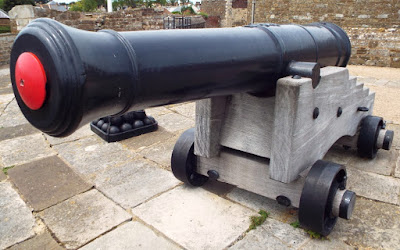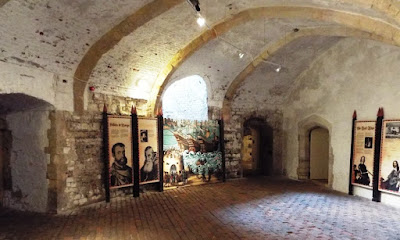On the same day that Sue and I visited Walmer Castle, we also paid a visit to the nearby Deal Castle. (The two castles are a mile apart.)
Like Walmer Castle, Deal Castle was one of the artillery forts that were built for Henry VIII to form part of a chain of coastal defences along the south coast of Kent. Like Walmer Castle, Deal Castle was built between 1539 and 1540.
Deal Castle also has a central three-storied round tower or keep, but in its case the tower has six small protruding bastions. The tower is encompassed by a circular courtyard (or ward), around which are arranged six larger, squat, semi-circular bastions upon which were mounted the castle’s heaviest guns. The whole castle is surrounded by a moat, and there is access into the moat via a sally port. A gallery with fifty three firing loops was constructed around the castle at the same level as the sally port so that defenders could fire at any attackers who managed to get into the moat.
The westernmost bastion is taller than the others and serves as the castle’s gatehouse. When built the castle’s tower provided accommodation for a peacetime garrison that comprised a castle commander (always referred to as the ‘Captain’), his deputy, a porter and sixteen gunners. The officers lived on the upper floor of the tower, and the kitchen and bakery were located on its ground floor. In the centre of the vaulted basement was a large well which supplied the castle’s fresh water needs. The basement also served as a storage area for supplies and as the castle’s magazine.
Deal Castle has always been commanded by a ‘Captain’, and since the eighteenth century this has been an honorific title bestowed on a soldier or politician of note. Over more recent years these have included:
... via the gateway in the westernmost bastion. (The short wooden bridge was originally a drawbridge that was operated from and protected by this bastion.)
This gave us access to the courtyard or ward that runs around the main tower and upper bastions of the castle.
This gave us an opportunity to examine the castle's main tower and upper bastions in some detail.
It also enabled us to see how effectively the castle's gun could protect this section of the Kent coast ...
... and to look at the cannons that are currently mounted atop the lower bastions.
We then went down to the lower level of the castle via a narrow staircase, ...
... through an equally narrow doorway, ...
... and into the vaulted basement. The only natural light in this area came from small windows that had formerly been firing loops.
In the centre of the basement is the castle's well ...
... and arranged around it are the castle's original store areas and magazines. The main storage areas now contain displays about the castle's history.
Coming off the basement are several narrow passages that lead to the gallery from which the defenders could fire into the moat.
There is also a narrow passageway that gives access via the sally port ...
... into the castle's moat.
We were able to walk completely around the moat ...
... and back through the sally port into the lower part of the castle.
We then made our way up a narrow winding staircase ...
... to the uppermost floor of the tower.
This was formerly the area used by the castle's Captain, ...
... and currently houses a small chapel dedicated to the memory of the Burma Star Association ...
... and portraits of some the former Captains of Deal Castle.
Whilst Deal Castle does not have the grandeur or historical importance of neighbouring Walmer Castle, it does give visitors a better understanding of how these artillery forts were constructed and how they functioned.
Like Walmer Castle, Deal Castle was one of the artillery forts that were built for Henry VIII to form part of a chain of coastal defences along the south coast of Kent. Like Walmer Castle, Deal Castle was built between 1539 and 1540.
Deal Castle also has a central three-storied round tower or keep, but in its case the tower has six small protruding bastions. The tower is encompassed by a circular courtyard (or ward), around which are arranged six larger, squat, semi-circular bastions upon which were mounted the castle’s heaviest guns. The whole castle is surrounded by a moat, and there is access into the moat via a sally port. A gallery with fifty three firing loops was constructed around the castle at the same level as the sally port so that defenders could fire at any attackers who managed to get into the moat.
The westernmost bastion is taller than the others and serves as the castle’s gatehouse. When built the castle’s tower provided accommodation for a peacetime garrison that comprised a castle commander (always referred to as the ‘Captain’), his deputy, a porter and sixteen gunners. The officers lived on the upper floor of the tower, and the kitchen and bakery were located on its ground floor. In the centre of the vaulted basement was a large well which supplied the castle’s fresh water needs. The basement also served as a storage area for supplies and as the castle’s magazine.
Deal Castle has always been commanded by a ‘Captain’, and since the eighteenth century this has been an honorific title bestowed on a soldier or politician of note. Over more recent years these have included:
- 1923 to 1925: Field Marshal, The Earl of Ypres, John French
- 1925 to 1927 Field Marshal Lord Allenby
- 1927 to 1934: Rufus Isaacs, Marquis of Reading
- 1934 to 1951: Field Marshal Lord Birdwood
- 1972 to 1979: General Sir Norman Tailyour, K.C.B., D.S.O.
- 1980 to 2009: Maj. Gen. Ian Harrison
- 2009 onwards: The title and position of ‘Captain of Deal Castle’ became part of the ceremonial role performed by the Commandant General, Royal Marines.
... via the gateway in the westernmost bastion. (The short wooden bridge was originally a drawbridge that was operated from and protected by this bastion.)
This gave us access to the courtyard or ward that runs around the main tower and upper bastions of the castle.
This gave us an opportunity to examine the castle's main tower and upper bastions in some detail.
It also enabled us to see how effectively the castle's gun could protect this section of the Kent coast ...
... and to look at the cannons that are currently mounted atop the lower bastions.
We then went down to the lower level of the castle via a narrow staircase, ...
... through an equally narrow doorway, ...
... and into the vaulted basement. The only natural light in this area came from small windows that had formerly been firing loops.
In the centre of the basement is the castle's well ...
... and arranged around it are the castle's original store areas and magazines. The main storage areas now contain displays about the castle's history.
Coming off the basement are several narrow passages that lead to the gallery from which the defenders could fire into the moat.
There is also a narrow passageway that gives access via the sally port ...
... into the castle's moat.
We were able to walk completely around the moat ...
... and back through the sally port into the lower part of the castle.
We then made our way up a narrow winding staircase ...
... to the uppermost floor of the tower.
This was formerly the area used by the castle's Captain, ...
... and currently houses a small chapel dedicated to the memory of the Burma Star Association ...
... and portraits of some the former Captains of Deal Castle.
Whilst Deal Castle does not have the grandeur or historical importance of neighbouring Walmer Castle, it does give visitors a better understanding of how these artillery forts were constructed and how they functioned.

















































.jpeg)





















would ditch be a better description than moat? The Halifax Citadel has a similiar ditch
ReplyDeleteIrishhighlander,
ReplyDeleteIt is described as a dry moat by English Heritage ... but it could equally be called a ditch.
All the best,
Bob
Stu Rat,
ReplyDeleteNineteen eh? I didn't know that it was that many! Better not mention it to the Chancellor of the Exchequer or he'll cut the numbers even further.
All the best,
Bob
How many Admirals do we have now?
ReplyDeleteChris Kemp,
ReplyDeleteMore than we have active warships!
All the best,
Bob